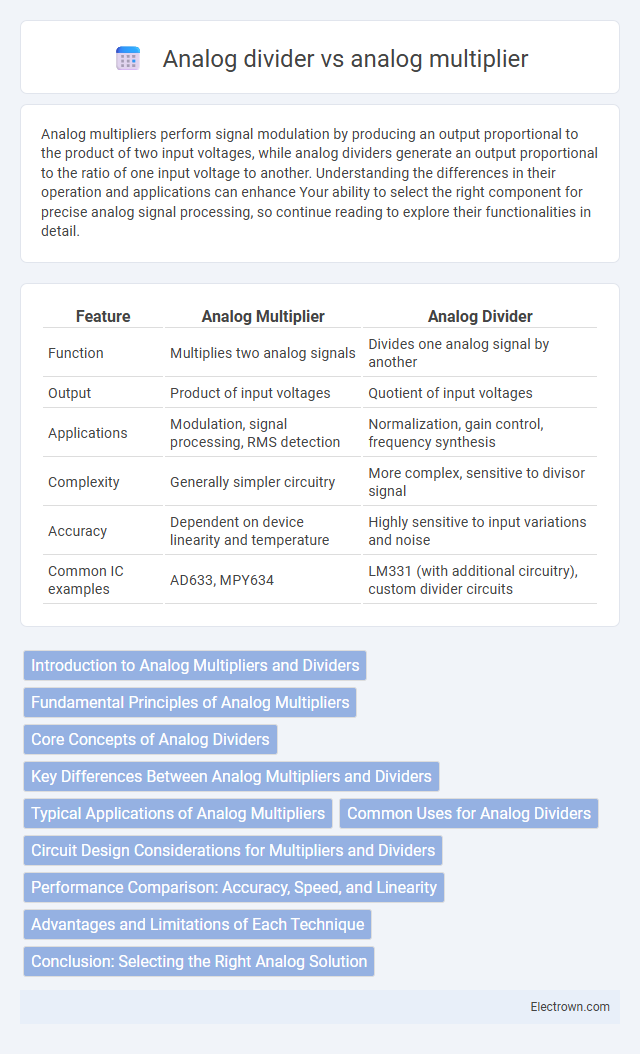Analog multipliers perform signal modulation by producing an output proportional to the product of two input voltages, while analog dividers generate an output proportional to the ratio of one input voltage to another. Understanding the differences in their operation and applications can enhance Your ability to select the right component for precise analog signal processing, so continue reading to explore their functionalities in detail.
Table of Comparison
| Feature | Analog Multiplier | Analog Divider |
|---|---|---|
| Function | Multiplies two analog signals | Divides one analog signal by another |
| Output | Product of input voltages | Quotient of input voltages |
| Applications | Modulation, signal processing, RMS detection | Normalization, gain control, frequency synthesis |
| Complexity | Generally simpler circuitry | More complex, sensitive to divisor signal |
| Accuracy | Dependent on device linearity and temperature | Highly sensitive to input variations and noise |
| Common IC examples | AD633, MPY634 | LM331 (with additional circuitry), custom divider circuits |
Introduction to Analog Multipliers and Dividers
Analog multipliers and dividers are essential components in analog signal processing, used to perform real-time arithmetic operations on continuous signals. Analog multipliers produce an output proportional to the product of two input voltages, enabling applications like modulation and signal mixing. Analog dividers, on the other hand, generate an output corresponding to the quotient of two input signals, useful in frequency synthesis and adaptive control systems where precise ratio calculations are required.
Fundamental Principles of Analog Multipliers
Analog multipliers operate by producing an output voltage proportional to the product of two input voltages, based on the nonlinear transfer characteristics of transistors or operational amplifiers configured in a specific feedback loop. They rely on the transconductance property, enabling precise and continuous-time multiplication essential for signal modulation, frequency conversion, and automatic gain control in analog circuits. Your applications benefit from the accurate scaling of signals without the digital quantization errors inherent in analog dividers, which perform inverse operations by outputting the ratio of input voltages through different configurations.
Core Concepts of Analog Dividers
Analog dividers operate by producing an output voltage proportional to the ratio of two input voltages, utilizing core principles such as translinear circuits and current-mode processing. They rely on the exponential relationship of bipolar junction transistors in their transistor arrays to achieve accurate division through the logarithmic domain. Unlike analog multipliers that multiply input signals directly, analog dividers transform division into subtraction in the log domain, enabling stable and precise division performance in signal processing applications.
Key Differences Between Analog Multipliers and Dividers
Analog multipliers perform signal processing by producing an output proportional to the product of two input voltages, commonly used in modulation and frequency conversion. Analog dividers generate an output voltage corresponding to the ratio of one input voltage to another, essential for tasks like normalization and feedback control. Understanding these key differences helps optimize your circuit design by selecting the appropriate component based on whether multiplication or division of analog signals is required.
Typical Applications of Analog Multipliers
Analog multipliers are widely used in signal processing for modulation, demodulation, and frequency mixing in communication systems. They enable precise amplitude modulation in variable gain amplifiers and serve critical roles in RMS power measurement and automatic gain control circuits. Their ability to multiply analog signals makes them essential for real-time signal analysis and control in instrumentation and audio processing.
Common Uses for Analog Dividers
Analog dividers are essential in applications requiring real-time ratio measurements, such as normalization of signals, frequency modulation, and phase-locked loops. They enable precise control in automatic gain control systems and instrumentation where signal division is necessary for accurate data processing. Unlike analog multipliers, which combine signals, analog dividers are specialized for applications demanding accurate division of voltages or currents in analog circuits.
Circuit Design Considerations for Multipliers and Dividers
Circuit design for analog multipliers demands careful consideration of linearity, temperature stability, and bandwidth to ensure accurate signal processing across varying input ranges. Analog dividers require precise control of input voltage levels and compensation for offset errors to maintain output fidelity, often necessitating additional calibration circuitry. Your choice between these components should factor in the complexity of implementation and the specific dynamic range requirements of your application.
Performance Comparison: Accuracy, Speed, and Linearity
Analog multipliers typically exhibit higher accuracy and linearity compared to analog dividers due to simpler circuit designs and fewer error-prone operations. Speed performance favors analog multipliers as they can process signals faster without the iterative steps common in analog division. Your choice depends on the required precision and response time, with multipliers generally outperforming dividers in both accuracy and speed for most applications.
Advantages and Limitations of Each Technique
Analog multipliers offer advantages such as straightforward implementation in signal modulation, easy integration with analog circuits, and real-time multiplication of input signals with low latency. Their limitations include susceptibility to nonlinearity errors, temperature dependence, and limited dynamic range affecting accuracy. Analog dividers enable direct division of voltages for signal processing tasks but often suffer from higher complexity, increased noise sensitivity, and slower response times compared to multipliers.
Conclusion: Selecting the Right Analog Solution
Choosing between an analog multiplier and an analog divider depends on the specific signal processing needs of your application. Analog multipliers excel in modulation and signal mixing tasks, offering precise control over proportional signals, while analog dividers are ideal for normalization and frequency synthesis where ratio calculation is essential. Understanding the role of each component ensures your circuit achieves optimal performance and accuracy in real-time analog computations.
Analog multiplier vs analog divider Infographic

 electrown.com
electrown.com